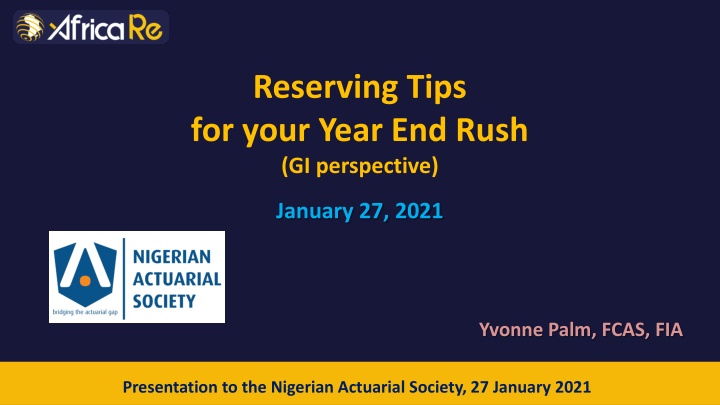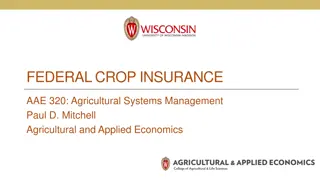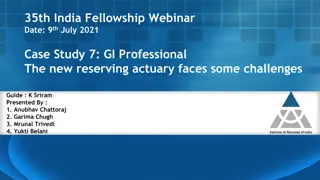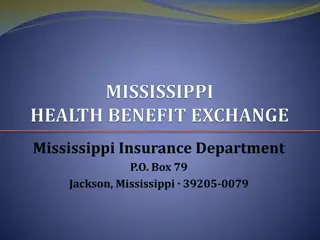Practical Tips for Year-End Reserving Analysis in General Insurance
Practical insights on enhancing reserving analysis in general insurance, stressing the significance of sound processes despite time constraints. Emphasizes selecting patterns, real versus expected reserving over time, useful diagnostics, and effective communication of results. Reminds not to rely solely on the Chain Ladder method, consider case reserves, and avoid blindly applying formulas. Encourages questioning the appropriateness of approaches and avoiding complacency. Highlights international standards and the importance of actuarial communication.
Download Presentation

Please find below an Image/Link to download the presentation.
The content on the website is provided AS IS for your information and personal use only. It may not be sold, licensed, or shared on other websites without obtaining consent from the author.If you encounter any issues during the download, it is possible that the publisher has removed the file from their server.
You are allowed to download the files provided on this website for personal or commercial use, subject to the condition that they are used lawfully. All files are the property of their respective owners.
The content on the website is provided AS IS for your information and personal use only. It may not be sold, licensed, or shared on other websites without obtaining consent from the author.
E N D
Presentation Transcript
Reserving Tips for your Year End Rush (GI perspective) January 27, 2021 Yvonne Palm, FCAS, FIA Presentation to the Nigerian Actuarial Society, 27 January 2021
Outline I. Introduction/Purpose II. Reminder of International Standards III.Some Basics IV.Selecting Patterns V.Reserving over time: Actual versus Expected VI.Useful Diagnostics VII.Communicating Your Results VIII.Questions 2 Y Palm, NAS 27 January 2021
Introduction/Purpose This presentation aims to give some practical tips to help enhance your reserving analysis. Reserves are the largest figures in the balance sheet, our processes should be sound even if we have to do them quickly. Assumes you already have basic knowledge of reserving. We are sticking with basic, triangular based, deterministic methods. Assumes you are working primarily in excel Set up may take some time, but will be worth it in the end. Trends are based on real situations but data has been changed. 3 Y Palm, NAS 27 January 2021
Overview of International Standards There are various international standards that are applicable to reserving. Widely recognized for GI are those from: International Standards of Actuarial Practice (IAA) general(catch-all) Institute & Faculty of Actuaries (UK) - prescriptive Actuarial Standards Board (US) - guidelines Other actuarial bodies (e.g. Australia, South Africa, Kenya NAS) Specific standards for a subscribed body (e.g. Lloyds, DIFC). All emphasise the importance of actuarial communication (verbal and aggregate report) and state that an actuarial report or communication should be such that an appropriately qualified person should be able to follow and understand the process, methodologies and assumptions and make an objective appraisal of the reasonableness of the actuary s work as presented. Communication of uncertainties is also key. Having another actuary peer review is important as well. Relevant standards include: International Standard of Actuarial Practice: ISAP1 IFoA APSX 2. Technical Actuarial Standards: TAS 100, 200 (UK) Actuarial Standards of Practice: ASOP 23, 36, 41, 43, 20 4 Y Palm, NAS 27 January 2021
Some Basics: DONTs DON T rely solely on the Chain ladder In the extreme case, if paid/incd losses are zero, the chain ladder is zero; would you really pick a zero ultimate? DON T use only one method You can apply more than one, just build it in, there are a few to choose from. DON T ignore case reserves Paid CL says $20m, but does it make sense as an ultimate if incurred claims are already $25m? DON T blindly apply a formula to your triangle to select your link ratios You could be biasing your numbers Be careful with averages, minimums, maximums, there could be trends as well. Your company can use a machine to just run a chain ladder without applying judgement Actuaries are valued for their judgement. DON T work at the back of your office in a silo Yes, I am talking to all of you who are loving working from home! DON T think just because the approach was fine last year it is fine this year Always question the appropriateness of what you are doing. Your data and book may be changing. 5 Y Palm, NAS 27 January 2021
Some Basics: DOs DO as much prep beforehand as possible (patterns, discussions, defaults, methods) DO speak to your underwriters/clients to understand the book of business Find out if there are any changes that can impact your analysis. Communicate results and seek feedback DO utilise as much relevant information as possible Inflation? Rate changes? Change in underlying product? Known Events you haven t seen come through? DO ensure you incorporate an exposure-based method Bornheutter-Ferguson method, Initial expected loss method etc DO split out large losses and cats They can distort your data and analysis. Cats may be seasonal. DO apply reasonable actuarial judgement when performing your analysis And this judgement should be well documented DO take a step back and assess your results for reasonableness DO use different colours to organize your spreadsheets 6 Y Palm, NAS 27 January 2021
What Methods Should I Select? Generally, Uncertainty I. Young ages: exposure based methods e.g. IELR, BF II. Ageing: methods that incorporate more loss history e.g. CL, mixture of methods III. Oldest years: more targeted methods specific to year: IBNR:OS, Incurred. No point projecting more development if all claims are closed. IV. Triangle based methods sometimes not necessarily good predictors for large losses. Frequency/Severity Parametric Speaking to business/claims May use BF-style method for IBNYR Age But There Is No Formula. Review data Analyze trends, Incorporate external knowledge, Utilize actuarial judgement IELR BF CL IBNR:OS Incurred 7 Y Palm, NAS 27 January 2021
Selecting Patterns The chain ladder link ratios we are very familiar with! Age-to-Age Factors 1-2 2-3 3-4 1.0433 1.0000 1.0199 1.0488 1.0175 1.0987 1.1314 1.0411 1.0180 1.0342 1.0083 1.0190 4-5 1.0015 1.0085 1.0145 1.0048 1.0458 1.0111 1.0091 1.0291 1.0125 1.0146 1.0453 5-6 0.9985 1.0074 1.0075 1.0023 1.0178 1.0037 1.0111 1.0020 1.0039 1.0250 6-7 1.0030 1.0042 1.0000 1.0003 1.0641 1.0010 1.0000 1.0000 1.0000 7-8 1.0000 1.0000 1.0000 1.0006 1.0013 1.0005 1.0052 1.0015 8-9 1.0000 1.0000 1.0000 1.0026 1.0000 1.0000 1.0000 9-10 1.0000 1.0000 1.0000 1.0000 1.0000 1.0005 Add other benchmarks if you have available data: Whole account Other region same LOB All regions combined same LOB All ST lines combined, all LT lines combined. By distribution or contract type? FAC/Treaty Figure out what is appropriate for your book 10-11 1.0000 1.0084 1.0000 1.0000 1.0000 11-12 1.0000 1.0000 1.0000 1.0000 12-13 1.0000 1.0000 1.0000 13-14 1.0000 1.0000 14-15 1.0000 2006 2007 2008 2009 2010 2011 2012 2013 2014 2015 2016 2017 2018 2019 2020 3.9722 2.9051 4.6193 2.7336 7.8039 5.6092 3.5730 5.2058 3.2150 5.0588 1.6477 2.2730 1.9239 2.4571 1.1311 1.2762 1.0924 1.1789 1.2933 1.2906 1.6524 1.1427 1.1182 1.0457 1.0403 1.0671 1.0835 Average All Weighted avg All Minimum Maximum Weighted avg last 3 Weighted avg last 5 Prior Selected factors CDF 3.7856 3.2942 1.6477 7.8039 2.1819 2.2891 3.2942 2.5000 2.8306 1.1856 1.1792 1.0403 1.6524 1.0595 1.0725 1.1792 1.0678 1.1323 1.0400 1.0425 1.0000 1.1314 1.0201 1.0251 1.0425 1.0253 1.0603 1.0179 1.0183 1.0015 1.0458 1.0237 1.0216 1.0183 1.0156 1.0342 1.0079 1.0078 0.9985 1.0250 1.0087 1.0081 1.0078 1.0062 1.0183 1.0081 1.0089 1.0000 1.0641 1.0000 1.0147 1.0089 1.0101 1.0120 1.0011 1.0012 1.0000 1.0052 1.0024 1.0017 1.0012 1.0013 1.0019 1.0004 1.0006 1.0000 1.0026 1.0000 1.0007 1.0006 1.0006 1.0006 1.0001 1.0001 1.0000 1.0005 1.0001 1.0001 1.0001 1.0000 1.0000 1.0017 1.0008 1.0000 1.0084 1.0000 1.0008 1.0008 1.0000 1.0000 1.0000 1.0000 1.0000 1.0000 1.0000 1.0000 1.0000 1.0000 1.0000 1.0000 1.0000 1.0000 1.0000 1.0000 1.0000 1.0000 1.0000 1.0000 1.0000 1.0000 1.0000 1.0000 1.0000 1.0000 1.0000 1.0000 1.0000 1.0000 1.0000 1.0000 1.0000 1.0000 1.0000 1.0000 1.0000 1.0000 1.0000 1.0000 1.0000 Have a few indicators to choose from, and don t be afraid to go off script if need be 8 Y Palm, NAS 27 January 2021
Selecting Patterns: Displaying Information Differently (1) Age-to-Age Factors 1-2 2-3 3-4 1.0433 1.0000 1.0199 1.0488 1.0175 1.0987 1.1314 1.0411 1.0180 1.0342 1.0083 1.0190 4-5 1.0015 1.0085 1.0145 1.0048 1.0458 1.0111 1.0091 1.0291 1.0125 1.0146 1.0453 5-6 0.9985 1.0074 1.0075 1.0023 1.0178 1.0037 1.0111 1.0020 1.0039 1.0250 6-7 1.0030 1.0042 1.0000 1.0003 1.0641 1.0010 1.0000 1.0000 1.0000 7-8 1.0000 1.0000 1.0000 1.0006 1.0013 1.0005 1.0052 1.0015 8-9 1.0000 1.0000 1.0000 1.0026 1.0000 1.0000 1.0000 9-10 1.0000 1.0000 1.0000 1.0000 1.0000 1.0005 10-11 1.0000 1.0084 1.0000 1.0000 1.0000 11-12 1.0000 1.0000 1.0000 1.0000 12-13 1.0000 1.0000 1.0000 13-14 1.0000 1.0000 14-15 1.0000 2006 2007 2008 2009 2010 2011 2012 2013 2014 2015 2016 2017 2018 2019 2020 3.9722 2.9051 4.6193 2.7336 7.8039 5.6092 3.5730 5.2058 3.2150 5.0588 1.6477 2.2730 1.9239 2.4571 1.1311 1.2762 1.0924 1.1789 1.2933 1.2906 1.6524 1.1427 1.1182 1.0457 1.0403 1.0671 1.0835 Average All Weighted avg All Minimum Maximum Weighted avg last 3 Weighted avg last 5 Prior Selected factors CDF 3.7856 3.2942 1.6477 7.8039 2.1819 2.2891 3.2942 2.5000 2.8306 1.1856 1.1792 1.0403 1.6524 1.0595 1.0725 1.1792 1.0678 1.1323 1.0400 1.0425 1.0000 1.1314 1.0201 1.0251 1.0425 1.0253 1.0603 1.0179 1.0183 1.0015 1.0458 1.0237 1.0216 1.0183 1.0156 1.0342 1.0079 1.0078 0.9985 1.0250 1.0087 1.0081 1.0078 1.0062 1.0183 1.0081 1.0089 1.0000 1.0641 1.0000 1.0147 1.0089 1.0101 1.0120 1.0011 1.0012 1.0000 1.0052 1.0024 1.0017 1.0012 1.0013 1.0019 1.0004 1.0006 1.0000 1.0026 1.0000 1.0007 1.0006 1.0006 1.0006 1.0001 1.0001 1.0000 1.0005 1.0001 1.0001 1.0001 1.0000 1.0000 1.0017 1.0008 1.0000 1.0084 1.0000 1.0008 1.0008 1.0000 1.0000 1.0000 1.0000 1.0000 1.0000 1.0000 1.0000 1.0000 1.0000 1.0000 1.0000 1.0000 1.0000 1.0000 1.0000 1.0000 1.0000 1.0000 1.0000 1.0000 1.0000 1.0000 1.0000 1.0000 1.0000 1.0000 1.0000 1.0000 1.0000 1.0000 1.0000 1.0000 1.0000 1.0000 1.0000 1.0000 1.0000 1.0000 1.0000 1.0000 Data visualization helps you spot trends you may not see just by looking at numbers in a triangle. 9 Y Palm, NAS 27 January 2021
Selecting Patterns: Displaying Information Differently (2) Selected Ultimate 677,000 965,000 2,404,000 3,129,000 2,376,000 1,925,000 1,925,000 1,990,283 1,785,382 1,370,261 1,550,915 720,830 1,045,473 979,201 687,698 CUMMULATIVE PAID CLAIMS 2006 2007 2008 2009 2010 2011 2012 2013 2014 2015 2016 2017 2018 2019 2020 144,000 253,000 457,000 916,000 204,000 238,000 281,000 311,000 479,000 238,000 843,000 282,000 473,000 350,000 222,000 572,000 735,000 2,111,000 2,504,000 1,592,000 1,335,000 1,004,000 1,619,000 1,540,000 1,204,000 1,389,000 641,000 910,000 860,000 647,000 938,000 2,306,000 2,952,000 2,059,000 1,723,000 1,659,000 1,850,000 1,722,000 1,259,000 1,445,000 684,000 986,000 675,000 938,000 2,352,000 3,096,000 2,095,000 1,893,000 1,877,000 1,926,000 1,753,000 1,302,000 1,457,000 697,000 676,000 946,000 2,386,000 3,111,000 2,191,000 1,914,000 1,894,000 1,982,000 1,775,000 1,321,000 1,523,000 675,000 953,000 2,404,000 3,118,000 2,230,000 1,921,000 1,915,000 1,986,000 1,782,000 1,354,000 677,000 957,000 2,404,000 3,119,000 2,373,000 1,923,000 1,915,000 1,986,000 1,782,000 677,000 957,000 2,404,000 3,121,000 2,376,000 1,924,000 1,925,000 1,989,000 677,000 957,000 2,404,000 3,129,000 2,376,000 1,924,000 1,925,000 677,000 957,000 2,404,000 3,129,000 2,376,000 1,925,000 677,000 965,000 2,404,000 2,404,000 2,404,000 3,129,000 3,129,000 2,376,000 677,000 965,000 677,000 965,000 677,000 965,000 677,000 986,000/1,045,473 = 94% 910,000/1,045,473 = 87% 473,000/1,045,473 = 45% Take each cell in your cumulative triangle an divide it by your selected ultimate claims. Yes it is a bit cyclical Yes that means your graph will change as your are working The chain ladder would essentially force the end of the year onto the selected pattern. Make sure your file is set up right before you start making selections, come back and look at your graph to as you are working along. 10 Y Palm, NAS 27 January 2021
Selecting Patterns: Displaying Information Differently (3) Pd to Ult: Class A 1 2 3 4 5 6 7 8 9 10 11 12 100% 100% 100% 100% #N/A #N/A #N/A #N/A #N/A #N/A #N/A #N/A #N/A #N/A #N/A 100% 100% 13 100% 100% 100% #N/A #N/A #N/A #N/A #N/A #N/A #N/A #N/A #N/A #N/A #N/A #N/A 100% 100% 14 100% 100% #N/A #N/A #N/A #N/A #N/A #N/A #N/A #N/A #N/A #N/A #N/A #N/A #N/A 100% 100% 15 100% #N/A #N/A #N/A #N/A #N/A #N/A #N/A #N/A #N/A #N/A #N/A #N/A #N/A #N/A 100% 100% 2006 2007 2008 2009 2010 2011 2012 2013 2014 2015 2016 2017 2018 2019 2020 21% 26% 19% 29% 9% 12% 15% 16% 27% 17% 54% 39% 45% 36% 32% 35% 24% 84% 76% 88% 80% 67% 69% 52% 81% 86% 88% 90% 89% 87% 88% 96% 97% 96% 94% 87% 90% 86% 93% 96% 92% 93% 95% 94% 100% 97% 98% 99% 88% 98% 98% 97% 98% 95% 94% 97% 100% 98% 99% 99% 92% 99% 98% 100% 99% 96% 98% 100% 99% 100% 100% 94% 100% 99% 100% 100% 99% 100% 99% 100% 100% 100% 100% 99% 100% 100% 100% 99% 100% 100% 100% 100% 100% 100% 100% 99% 100% 100% 100% 100% 100% 100% 99% 100% 100% 100% 100% 100% 100% 100% 100% 100% #N/A #N/A #N/A #N/A #N/A #N/A #N/A #N/A #N/A #N/A #N/A #N/A #N/A #N/A #N/A #N/A #N/A #N/A #N/A #N/A #N/A #N/A #N/A #N/A #N/A #N/A #N/A #N/A #N/A #N/A #N/A #N/A #N/A #N/A #N/A #N/A #N/A #N/A #N/A #N/A #N/A #N/A #N/A #N/A #N/A #N/A #N/A #N/A #N/A #N/A #N/A #N/A #N/A #N/A #N/A Selected Prior Selected 88% 78% 94% 92% 97% 96% 98% 98% 99% 99% 100% 100% 100% 100% 100% 100% 100% 100% 100% 100% Calculated from triangle Including the =NA() error-catching excel formula important here when there are empty cells. Otherwise each line on your graph will go straight to zero on its right end. = 1/CDF at each point 11 Y Palm, NAS 27 January 2021
Selecting Patterns: Displaying Information Differently (4) Each year from the triangle is a series The older, more developed years are pretty much set in their ways, particularly for short tail lines Using a colour scheme helps, this one uses rainbow colours to highlight more recent years. You can set up your graphs to exclude certain years (macro, formula etc.) 12 Y Palm, NAS 27 January 2021
Selecting Patterns: Displaying Information Differently (5) Removed years older than 2014 Prior pattern now clearly way off If selected pattern below year lines Pattern is too slow You will over project your ultimate Reduce the selected link ratios in the affected area If pattern above year lines Pattern is too fast You will under project your ultimates Increase the selected link ratios in the affected area) Consider if the past is really going to be a predictor of the future. 13 Y Palm, NAS 27 January 2021
Selecting Patterns: Dont ignore tail factors (1) INCREMENTAL PAID CLAIMS 1 791,000 652,000 1,233,000 1,761,000 1,005,000 1,179,000 1,132,000 2,163,000 1,858,000 2,425,000 3,290,000 2 3 4 5 601,000 1,077,000 563,000 720,000 860,000 713,000 562,000 6 7 8 9 10 241,000 101,000 11 100,000 2006 2007 2008 2009 2010 2011 2012 2013 2014 2015 2016 1,640,000 2,116,000 5,091,000 4,155,000 3,533,000 3,714,000 3,107,000 4,249,000 4,699,000 4,427,000 1,116,000 1,685,000 1,511,000 2,416,000 1,843,000 2,076,000 3,132,000 1,642,000 1,582,000 759,000 1,225,000 1,783,000 1,093,000 1,374,000 1,255,000 1,233,000 978,000 Age-to-Age Factors 1,142,000 328,000 353,000 331,000 585,000 573,000 215,000 446,000 217,000 328,000 403,000 311,000 262,000 389,000 208,000 121,000 310,000 230,000 1-2 2-3 3-4 4-5 5-6 6-7 7-8 8-9 9-10 10-11 2006 2007 2008 2009 2010 2011 2012 2013 2014 2015 2016 3.073 4.245 5.129 3.359 4.515 4.150 3.745 2.964 3.529 2.826 1.459 1.609 1.239 1.408 1.406 1.424 1.739 1.256 1.241 1.214 1.275 1.228 1.131 1.215 1.180 1.167 1.121 1.140 1.190 1.059 1.076 1.111 1.087 1.065 1.233 1.049 1.035 1.033 1.068 1.064 1.036 1.063 1.021 1.031 1.044 1.050 1.035 1.036 1.019 1.018 1.040 1.021 1.036 1.012 1.014 Longer tail line, triangle as at end of 2016 No tail assumed in this selection Average All Weighted All Minimum Maximum Weighted 3 Weighted 5 Prior Selected factors CDF 3.754 3.587 2.826 5.129 3.075 3.306 3.587 3.075 5.860 1.420 1.386 1.239 1.739 1.369 1.386 1.386 1.369 1.906 1.191 1.183 1.121 1.275 1.155 1.160 1.183 1.130 1.392 1.104 1.095 1.059 1.190 1.087 1.078 1.095 1.087 1.232 1.080 1.067 1.033 1.233 1.054 1.049 1.067 1.033 1.133 1.039 1.037 1.021 1.063 1.031 1.037 1.037 1.031 1.097 1.035 1.033 1.019 1.050 1.030 1.026 1.026 1.018 1.040 1.026 1.024 1.023 1.012 1.036 1.023 1.014 1.014 1.014 1.014 1.014 1.033 1.015 1.064 1.026 1.010 1.048 1.023 1.023 1.038 1.014 1.014 1.014 14 Y Palm, NAS 27 January 2021
Selecting Patterns: Dont ignore tail factors (2) INCREMENTAL PAID CLAIMS 1 791,000 652,000 1,233,000 1,761,000 1,005,000 1,179,000 1,132,000 2,163,000 1,858,000 2,425,000 3,290,000 2 3 4 5 6 7 8 9 10 241,000 101,000 239,000 168,000 414,000 317,000 11 100,000 93,000 204,000 206,000 503,000 12 13 14 15 60,000 2006 2007 2008 2009 2010 2011 2012 2013 2014 2015 2016 1,640,000 2,116,000 5,091,000 4,155,000 3,533,000 3,714,000 3,107,000 4,249,000 4,699,000 4,427,000 3,929,000 1,116,000 1,685,000 1,511,000 2,416,000 1,843,000 2,076,000 3,132,000 1,642,000 1,582,000 2,537,000 3,188,000 759,000 1,225,000 1,783,000 1,093,000 1,374,000 1,255,000 1,233,000 978,000 1,151,000 1,666,000 2,284,000 601,000 1,077,000 563,000 720,000 860,000 713,000 562,000 872,000 1,233,000 1,329,000 2,629,000 1,142,000 328,000 353,000 331,000 585,000 573,000 505,000 719,000 853,000 2,211,000 215,000 446,000 217,000 328,000 403,000 426,000 867,000 785,000 1,049,000 311,000 262,000 389,000 208,000 279,000 590,000 494,000 936,000 121,000 310,000 230,000 296,000 413,000 331,000 863,000 113,000 145,000 204,000 142,000 179,000 138,000 128,000 158,000 122,000 How can I estimate them? Consider what you know about the business. Use various methods to estimate Multiple of last few factors Inverse squares method Extrapolate into future Consider open claim counts Compare to other classes/data https://www.casact.org/pubs/forum/13fforum/02-Tail- Factors-Working-Party.pdf Same triangle four years later, a further $1.4m development just on these four fully developed years alone and they are not done! Every year is systematically understated. Can add up to significant amounts It is a growing book, the problem could get worse in $ terms But don t just select high numbers, tail factors have a leveraged effect!!! 15 Y Palm, NAS 27 January 2021
Picking Initial Expected Loss Ratios Indicated IELR 36.1% 51.3% 31.7% 189.5% 67.0% 53.8% 78.3% 77.1% 64.9% 50.1% 88.6% 87.1% 81.7% 64.4% 28.4% Selected IELR I. Have an indicated IELR: Use ultimate premium and an a priori ultimate claims estimate of your ultimate claims. Can use the CL result, or previous ULR, etc. for this. 2006 2007 2008 2009 2010 2011 2012 2013 2014 2015 2016 2017 2018 2019 2020 36.1% 51.3% 31.7% 189.5% 67.0% 53.8% 78.3% 77.1% 64.9% 50.1% 88.6% 87.1% 81.7% 69.1% 70.5% II. The average loss ratio may not be appropriate. Is there a trend? Each year would have unique IELR. Indicated IELR 47.7% 52.4% 62.2% 50.6% 50.7% 49.2% 54.3% 63.1% 56.2% 53.0% 67.3% 82.6% 92.6% 88.0% 111.9% Selected IELR 47.7% 52.4% 62.2% 50.6% 50.7% 49.2% 54.3% 63.1% 56.2% 53.0% 67.3% 82.6% 92.6% 87.6% 89.9% III. Are other factors affecting my initial expected loss ratios? 2006 2007 2008 2009 2010 2011 2012 2013 2014 2015 2016 2017 2018 2019 2020 Have rates been decreasing? Do I need to adjust for this? How is inflation affecting my figures? Do I need to adjust for this also? Has the business changed? Is the business growing/shrinking? Have economic factors affected the book? Other impacts? COVID? 16 Y Palm, NAS 27 January 2021
A side note on COVID I. Could impact your book in multiple ways, depends on lines of business. Motor/Travel/Hospitality: Lower frequency Fire/Property/Aviation: we may not have seen it yet, but could be higher severity with buildings/assets not being properly maintained or being semi-abandoned Medical/Health/Contingency/Events: have you been covering it? The all important question about BI claims. Has the economic situation affected the book of business? II. Increased fraudulent claims? Would this be coming through on the older years? III. Have our patterns changed? Maybe we have less claims being reported now, does that mean we really have lower ultmates? Are insureds just taking more time to reported claims because people are not assessing damage. There could be pressures in companies/individuals due to staff being out sick 17 Y Palm, NAS 27 January 2021
Reserving over time: Actual vs Expected Analysis (1) Projecting reasonable loss reserves is not a static exercise. Monitoring how well your projections are performing over time is important. Perform an actual versus expected analysis. You can actually do this before you start your reserving exercise. It is mechanical! What is needed: Last time s ultimates Last time s pattern (Paid/Incd) Previous and latest claims positions (Paid/Incd) An AvsE is simply an analysis where your actual movement in the period (Paid/Incurred) is compared to the expected movement in the period. Gives insight into how good your prior ultimates and your pattern selections were. 18 Y Palm, NAS 27 January 2021
Reserving over time: Actual vs Expected Analysis (2) = ? ?? = Paid CDF for age a, thus ?? = Full Year Ultimateat time t ?? = Cumulative Paid at time t ?? = % paid at age a Actual = ?? - ?? ? Remember, you are using patterns and ultimates from your prior analysis ??? ??? ? ??? ? ?? ? ?? ? Expected = ? Can do same on incurred basis by using incurred CDFs and Incurred Claims. 19 Y Palm, NAS 27 January 2021
AvsE: What can you do with it? (1) It can give you indications into whether you need to adjust your patterns and/or ultimates, and if you have adjusted enough. Objective is to have small random movements and total AvsE to be close to zero. Expt Pd Actual Pd YOA 2011 2012 2013 2014 2015 2016 2017 2018 2019 AvsE Ult mvt 2,000 13,000 15,000 433 110 16,000 3,000 26,000 766,000 0 0 0 0 0 -2,000 -13,000 -15,000 -433 -110 -2,000 -13,000 -17,000 -3,000 If there is a pattern in your AvsE, it is likely that your pattern is wrong. If all going one direction, probably an issue on your tail factor. 0 2,802,000 2,786,000 730,000 925,000 1,295,000 2,802,000 752,000 1,192,000 1,383,000 727,000 899,000 529,000 Your ultimate movement is likely going to be greater in magnitude than your AvsE AvsE is over a given period, ultimate is to full closure of the year. Total 841,543 5,752,000 4,910,457 6,094,000 20 Y Palm, NAS 27 January 2021
AvsE: What can you do with it? (2) It can help you better analyze your ultimate movement. Prior ULR times movement in ultimate premium Mvt due to Exposure Mvt due to Experience Mvt due to Mthd/Assm YOA AvsE 2011 2012 2013 2014 2015 2016 2,786,000 2017 2018 2019 Ult mvt -2,000 -13,000 -15,000 -433 -110 -2,000 -13,000 -17,000 -3,000 0 0 0 0 0 0 -2,000 -13,000 -15,000 -433 -110 2,786,000 727,000 899,000 529,000 0 0 -2,000 -2,567 110 16,000 115,899 197,767 650,056 0 2,802,000 752,000 1,192,000 1,383,000 727,000 899,000 529,000 -90,899 95,233 203,944 Set equal to the AvsE Total 4,910,457 6,094,000 208,279 4,910,457 975,264 *Can make calculation more complex and calculate methods before and after assumption changes, so this column can be split further. 21 Y Palm, NAS 27 January 2021
AvsE: What can you do with it? (3) When there are tight schedules, you can use it for a roll-forward process. Minimum changes as possible Gage reasonableness in your overall ultimate movement by comparing it with the AvsE AvsE is for period, Ultimate is to settlement. Not recommended if you only do reserving annually or projections unstable A deep dive should be done at least annually Expt Pd Actual Pd YOA 2011 2012 2013 2014 2015 2016 2017 2018 2019 AvsE Ult mvt 2,000 13,000 15,000 433 110 16,000 3,000 26,000 766,000 0 0 0 0 0 -2,000 -13,000 -15,000 -433 -110 0 0 0 0 0 2,802,000 2,786,000 730,000 925,000 1,295,000 3,000,000 500,000 1,000,000 1,500,000 727,000 899,000 529,000 Usually exposure volumes are changing on most recent year, sometimes it is best to use a loss ratio approach. Total 841,543 5,752,000 4,910,457 6,000,000 Can re-project methods using same assumptions (i.e. patterns and IELRS), but use latest data. 22 Y Palm, NAS 27 January 2021
Further Note on Roll-Forwards Year end timelines can be tight, and will get tighter with IFRS17. The idea of a thorough review at Q3 (or Nov) and a roll-forward is something you should be considering. Fast close processes will become more frequent. Examples of Roll-Forward methodology: Attritional: Maintain Ultimates, change only what is necessary (AvsE Method) Maintain ULRs, update for volumes, use AvsE to show it is still reasonable Maintain patterns and method selections, use mechanical ultimates BF method, use previous ULR as IELR. Large/Cat: At the most basic level, update for latest incurred at the minimum Speak to claims and underwriters and understand if you need to add an element of IBNER (Incurred But Not Enough Reported) on specific claims There is the issue of IBNYR (Incurred But Not Yet Reported), particularly for large. You can address this using Large IELRs * Exposed Premium * % Unreported for large (like a BF for large losses) You would still need to gage your results for reasonableness. IFOA Paper: Towards the Optimal Reserving Process CAS 2014 CLRS Roll-Forward Reserve Estimates session: https://cas.confex.com/cas/clrs14/webprogram/Session7412.html 23 Y Palm, NAS 27 January 2021
Taking a Step Back Once you are done with your initial selections, take a step back and just ask yourself: Do my numbers make sense? ? Is my selected loss ratio for the latest year within a reasonable range? ? Have I projected future development on years where all the claims are closed? ? Have I projected negative IBNR on some years even though our case reserves are never redundant? ? Have my ultimates grown/reduced in line with exposure changes? Take a step back, look at overall reasonableness (See woods from trees). 24 Y Palm, NAS 27 January 2021
Recommended Diagnostics: Graph your results (1) Final Selected Ult IELR Mthd Paid CL Paid BF IBNR:OS ILR Prior Ult 2006 2007 2008 2009 2010 2011 2012 2013 2014 2015 2016 2017 2018 2019 2020 39% 54% 34% 192% 70% 56% 81% 80% 67% 53% 91% 90% 84% 73% 74% 39% 54% 34% 192% 70% 56% 81% 80% 67% 53% 91% 90% 84% 67% 31% 39% 54% 34% 192% 70% 56% 81% 80% 67% 53% 91% 90% 84% 68% 53% 39% 54% 34% 192% 70% 56% 81% 80% 67% 53% 92% 89% 82% 66% 45% 39% 54% 34% 192% 70% 56% 81% 80% 67% 53% 92% 89% 82% 61% 18% 39% 54% 34% 192% 70% 56% 81% 80% 67% 53% 92% 90% 82% 68% 53% 39% 54% 34% 192% 70% 56% 81% 80% 68% 53% 92% 86% 58% 46% You can review your ultimate loss ratio figures and gage for reasonableness. However, putting them in a graph will give you a lot more insight into if the results are reasonable. 25 Y Palm, NAS 27 January 2021
Recommended Diagnostics: Graph your results (2) What does this graph tell you? Easily identified that there was a large loss impacting 2009 Higher uncertainty in more recent years shown by divergence in results The results seem cyclical perhaps the insurance cycle at play? The chain ladder method is out of the question for 2020. There is an increasing trend over time Our recent years may just be too low We did the same thing last year perhaps we need to select the IELR method instead? 26 Y Palm, NAS 27 January 2021
Recommended Diagnostics: Graph your results (3) Another example Significant dispersion CL inappropriate Paid methods alone inadequate Growing book, pattern has been changing significantly over time May be worth selecting two different patterns. Can be done before your year end rush!! 27 Y Palm, NAS 27 January 2021
Additional Diagnostics (1) Calculate a survival ratio of your reserves Indicates the number of years your reserves will last for. Survival Ratio = Total Reserves / paid during year Both actual and expected paid can be used. Understand deviations. Compare to average term from your triangle. Does it make sense for a long or short tail LOB? Consider incurred basis by looking at available IBNR versus IBNR burn in a year Remember to consider size of book. Split your ultimates into the different pots to see if they make sense: Paid/Outstanding/IBNR Look at the earned versus unearned IBNR. May often indicate an issue in your earnings methodology Your loss ratios are too low if your earned IBNR is always negative. 28 Y Palm, NAS 27 January 2021
Additional Diagnostics (2) Examine your prior year development amounts. Understand what is driving each movement Use the techniques that were shown in the AvsE slides Is it due to a specific claim, or groups of claims? Is there a systemic issue? If the movements are happening on older years, why are they happening now? Track your ultimates over time. Like a triangle of ultimates Examine and see if there are upwards or downwards trends Can use reserving monitoring statistics for risk metrics. Track years/quarters of reserve deteriorations Compare magnitude of deteriorations to reserve risk in capital model. Track adequacy of case reserving, can help you understand and adjust for changes in case reserving practices. Set up as much as possible beforehand and let it auto-update, the more info at your fingertips the easier to gage reasonableness quickly. 29 Y Palm, NAS 27 January 2021
Communication is Key Document your important assumptions, or deviations from your described methodology. Good documentation makes things easier next time! Point out the uncertainties, quantify them if you can. It is all uncertain, but convince the person reading that it reasonable Elements of a good actuarial report 1) 2) 3) 4) 5) 6) 7) 8) Appendices as appropriate Introduction & Scope Executive Summary Description of Business Methodology & Assumptions Results Uncertainties Data appropriately qualified person should be able to follow and understand the process, methodologies and assumptions and make an objective appraisal of the reasonableness . 30 Y Palm, NAS 27 January 2021
Comments On Discussions with Auditors Don t panic, they are there to help ensure reasonableness. Approach it as a cooperative effort to ensure soundness. I. Overview discussion of the book of business. You want them to understand the business to reduce the back and forth before you come onto the same page. If your report is really good, they can get much of the relevant background on the business from there. II. Discussion about changes in the business or anything that they should be aware of. Think back to your discussions and analysis, was there anything you made adjustments for after hearing from the underwriters? What about COVID? III. Be ready with a comparison to last year s numbers. IV. Discuss the results before they send them to management, if this is not planned, request for it. As actuaries who abide by a code of conduct, the auditors too should give you sufficient information for you to understand their work and make an objective appraisal. V. Don t be afraid to ask questions about what they did. You should understand exactly why their numbers are different if they are. Maybe you need to change something in your analysis Maybe you will be able to point out something you have adjusted for that they were not aware of. Further reading: ASOP 21 refers to working with auditors 31 Y Palm, NAS 27 January 2021
Questions? 32 Y Palm, NAS 27 January 2021























